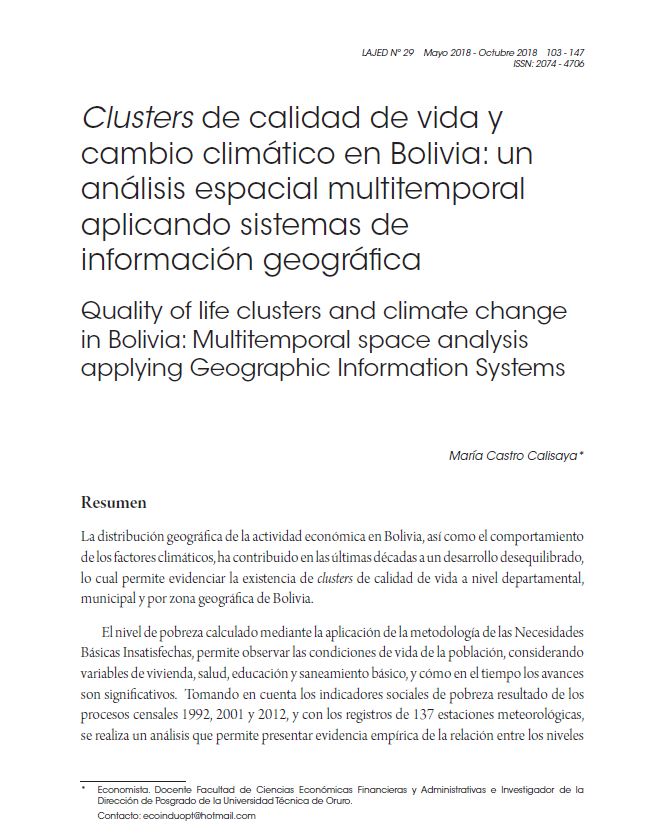Quality of life clusters and climate change in Bolivia: Multitemporal space analysis applying Geographic Information Systems
DOI:
https://doi.org/10.35319/lajed.20182921Keywords:
Poverty, Climate Change, Space Econometrics, Geographic Information SystemsAbstract
The geographical distribution of economic activity in Bolivia, as well as the behavior of climatic factors, has contributed in the last decades to an unbalanced development, which makes it possible to demonstrate the existence of clusters of quality of life at the departmental, municipal and geographic levels from Bolivia. The poverty level calculated through the application of the methodology of the Unsatisfied Basic Needs, allows observing the living conditions of the population considering variables of housing, health, education and basic sanitation, and how in time the advances are significant. Taking into account the Poverty Social Indicators as a result of the 1992, 2001 and 2012 census processes and with the records of 137 weather stations, an analysis is carried out that allows us to present empirical evidence of the relationship between poverty levels at the municipal level in Bolivia and the variables of climate change: temperature and level of precipitation, using spatial econometric techniques in three cross section and geographic information systems.
Downloads
References
Andersen E., Lykke y Rubén Mamani P. 2009. “Cambio climático en Bolivia hasta 2100: síntesis de costos y oportunidades”. Proyecto “Estudio regional de economía del cambio climático en Sudamérica” (ERECC-SA), coordinado por CEPAL y Banco Interamericano de Desarrollo. Bolivia.
Andersen E., Lykke y Dorte Verner. 2010. “Social Impacts of Climate Change in Mexico: A municipality level analysis of the effects of recent and future climate change on human development and inequality”. Instituto de Estudios Avanzados en Desarrollo, La Paz, Bolivia. Banco Mundial, Washington, DC.
---------- 2010b. “Simulating the Effects of Climate Change on Poverty and Inequality” en Reducing Poverty, Protecting Livelihoods, and Building Assets in a Changing Climate. Social Implications of Climate Change for Latin America and the Caribbean. The World Bank. Washington, DC.
Anderson, Simón. 2011. “Cambio climático y reducción de la pobreza”. Grupo de Cambio Climático en el Instituto Internacional para el Ambiente y Desarrollo. Alianza Clima y Desarrollo. Programa Internacional del Reino Unido.
Comisión Económica para América Latina y el Caribe y Programa de las Naciones Unidas para el Desarrollo, CEPAL-PNUD. 1990. “Proyecto regional para la superación de la pobreza”. Colombia
Comisión Económica para América Latina y el Caribe, CEPAL. 2014. Panorama Social en América Latina (LC/G.2635-p), Santiago de Chile.
---------- 2000b. “Panorama social de América Latina 1999-2000. Síntesis”. Disponible en: HYPERLINK "http://www.eclac.org" www.eclac.org
Galindo, L. 2009. “La economía del cambio climático en México”. Secretarias de Hacienda y Crédito Público y de Medio Ambiente y Recursos Naturales. México D.F.
Ganuza, Enrique, Ricardo Paes de Barros y Rob Vos. 2002. “Efectos de la liberalización sobre la pobreza y desigualdad”. Cuadernos de Desarrollo Humano Sostenible. Estados Unidos Programa de las Naciones Unidas para el Desarrollo, PNUD.
GeoBolivia/UDAPE/PMA-ONU. “Mapa muestra de indicadores sociales de pobreza, necesidades básicas insatisfechas y vulnerabilidad a la seguridad alimentaria a nivel municipal”.
Grupo Intergubernamental de Expertos sobre el Cambio Climático, IPCC. 2014. Quinto informe de evaluación del “Cambio climático 2014 Impactos, adaptación y vulnerabilidad”. Suiza.
Grupo Intergubernamental de Expertos sobre el Cambio Climático, IPCC. 2008. Cuarto Informe de evaluación del “Cambio climático 2007: Informe de síntesis. Contribución de los Grupos de trabajo I, II y III”. Suiza.
Helvetas, Swiss Intercooperation. 2014. “Eventos extremos a partir de escenarios climáticos. Análisis en municipios rurales de Bolivia: zonas andinas y valles”. Programa de reducción del riesgo de desastres de la cooperación suiza en Bolivia. Bolivia.
Hoffmann, Dirk y Cecilia Requena. 2012. “Bolivia en un mundo 4 grados más caliente. Escenarios sociopolíticos ante el cambio climático para los años 2030 y 2060 en el altiplano norte” Programa de Investigación Estratégica en Bolivia-Instituto Boliviano de la Montaña. Bolivia.
Horowits. J. 2009. The Income-Temperature Relationship in a Cross-Section of Countries and its Implications for Predicting the Effects of Global Warming. Environmental and Resourse Economics.
Organización de las Naciones Unidas para la Educación, la Ciencia y la Cultura, UNESCO. 2015. Poverty. Learning to live together.
Programa de las Naciones Unidas para el Desarrollo, PNUD. 2007. “Informe Nacional sobre Desarrollo Humano 2007: el estado del Estado en Bolivia. Bolivia.
Programa de las Naciones Unidas para el Desarrollo, PNUD. 2015/2016. “Informe nacional sobre desarrollo humano. Más allá del conflicto, luchas por el bienestar”. Guatemala.
Sen, Amartya. 2000. Desarrollo y libertad. Argentina: Planeta.
Unidad de Análisis de Políticas Sociales y Económicas, UDAPE. 2013. Comité Interinstitucional de las Metas de Desarrollo del Milenio (CIMDM). “Séptimo informe de progreso de los Objetivos de Desarrollo del Milenio en Bolivia”. Bolivia.
Banco Mundial. 2000b. Understanding Poverty. Disponible en http://www.worldbank. org/poverty/mission/up1.htm






